highonthai
50cc
LEAKDOWN TEST
Wondering why you can’t get your engine to idle correctly? Engine running lean? You’re sure you have checked everything and still can’t figure it out?
Well you probably have an air leak somewhere.
How do I find out if I have an air leak that’s effecting my engines performance?
Well, the best way to figure out if your two-stroke RC airplane engine has an air leak. Test it!
These leaks include anything coming from the crank seals,cylinder head gasket, base gasket, the spark plug threads, intake manifold, or exhaust manifold. No matter where these air leaks originate, they affect the performance of your engine, making the engine difficult to tune, and are not normal for a healthy engine and will eventually end up costing you your engine if not the whole plane.
Performing a leak down test is the best method for determining if and where air leaks are coming from.
A leak down test is fairly simple to perform test (if you have the right equipment) and can provide tremendous amounts of information about the health of an engine. I typically like to perform a leak down test on an engine if I’m having trouble tuning the engine consistently, if I’ve bought a used engine with a suspect past history,or when I’m finishing up assembling a new engine.
The biggest mistake I see allot of people make is when they rebuild an engine with new parts and skip the leak down test.
I cannot count the number of times where I have rebuilt an engine with new parts and then performed a leak down test to find a gasket that was not sealing properly or another part that was causing a problem. The leak down test is imperative and ultimately becomes a form of cheap insurance against the time and money that has gone into the build...
Highpoint 2 Stroke Engine Leak Down Test.
Pressure testing is a test performed on a two-stroke engine to ensure that the engine has no air leaks. An air leak in a two-stroke engine can cause a lean condition in engine fuel-air mixture. This in turn can result in engine overheating, piston seizure, detonation, hard starting, erratic idle, etc.
WARNING!
Don’t not use an air compressor.
Wear eye protection to prevent eye injury from escaping gas and/or flying particles. We recommend that a qualified mechanic in a properly equipped shop perform this procedure.
1. To perform a leak down test on the engine: cylinder, head, reed cage, intake manifold and spark plug must all be installed and torque correctly. Exhaust pipe and carburetor must be removed.
2. Seal the exhaust ports with the correct size block off plate and rubber gasket.
3. Seal the correct size carburetor adapter block off plate.
4. Attach the hose (from the pump/ gauge assembly) into the Schrader valve.
5. With all test equipment in place and the piston at bottom dead center, use the hand pump to pump 6 PSI of air pressure into engine. Never exceed 8 PSI of air pressure or damage to the seals and/or engine may occur. If loss of air pressure occurs, spray soapy water over mating surfaces to see where soap bubbles appear. Repair any leaks that may appear and redo test. A leakage rate of 1 PSI per minute is acceptable; however the lower the leakage rate the better your engine will perform.
Leak down kits are available at highpoint/pro tune stick https://protunestick.ecwid.com
Scott
High point / pro tune stick
Wondering why you can’t get your engine to idle correctly? Engine running lean? You’re sure you have checked everything and still can’t figure it out?
Well you probably have an air leak somewhere.
How do I find out if I have an air leak that’s effecting my engines performance?
Well, the best way to figure out if your two-stroke RC airplane engine has an air leak. Test it!
These leaks include anything coming from the crank seals,cylinder head gasket, base gasket, the spark plug threads, intake manifold, or exhaust manifold. No matter where these air leaks originate, they affect the performance of your engine, making the engine difficult to tune, and are not normal for a healthy engine and will eventually end up costing you your engine if not the whole plane.
Performing a leak down test is the best method for determining if and where air leaks are coming from.
A leak down test is fairly simple to perform test (if you have the right equipment) and can provide tremendous amounts of information about the health of an engine. I typically like to perform a leak down test on an engine if I’m having trouble tuning the engine consistently, if I’ve bought a used engine with a suspect past history,or when I’m finishing up assembling a new engine.
The biggest mistake I see allot of people make is when they rebuild an engine with new parts and skip the leak down test.
I cannot count the number of times where I have rebuilt an engine with new parts and then performed a leak down test to find a gasket that was not sealing properly or another part that was causing a problem. The leak down test is imperative and ultimately becomes a form of cheap insurance against the time and money that has gone into the build...
Highpoint 2 Stroke Engine Leak Down Test.
Pressure testing is a test performed on a two-stroke engine to ensure that the engine has no air leaks. An air leak in a two-stroke engine can cause a lean condition in engine fuel-air mixture. This in turn can result in engine overheating, piston seizure, detonation, hard starting, erratic idle, etc.
WARNING!
Don’t not use an air compressor.
Wear eye protection to prevent eye injury from escaping gas and/or flying particles. We recommend that a qualified mechanic in a properly equipped shop perform this procedure.
1. To perform a leak down test on the engine: cylinder, head, reed cage, intake manifold and spark plug must all be installed and torque correctly. Exhaust pipe and carburetor must be removed.
2. Seal the exhaust ports with the correct size block off plate and rubber gasket.
3. Seal the correct size carburetor adapter block off plate.
4. Attach the hose (from the pump/ gauge assembly) into the Schrader valve.
5. With all test equipment in place and the piston at bottom dead center, use the hand pump to pump 6 PSI of air pressure into engine. Never exceed 8 PSI of air pressure or damage to the seals and/or engine may occur. If loss of air pressure occurs, spray soapy water over mating surfaces to see where soap bubbles appear. Repair any leaks that may appear and redo test. A leakage rate of 1 PSI per minute is acceptable; however the lower the leakage rate the better your engine will perform.
Leak down kits are available at highpoint/pro tune stick https://protunestick.ecwid.com
Scott
High point / pro tune stick
Attachments
-
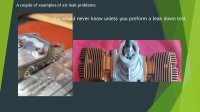 Slide1.JPG135.9 KB · Views: 1,865
Slide1.JPG135.9 KB · Views: 1,865 -
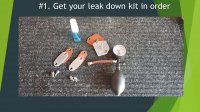 Slide2.JPG325.3 KB · Views: 781
Slide2.JPG325.3 KB · Views: 781 -
 Slide3.JPG210.2 KB · Views: 858
Slide3.JPG210.2 KB · Views: 858 -
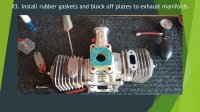 Slide4.JPG191.6 KB · Views: 878
Slide4.JPG191.6 KB · Views: 878 -
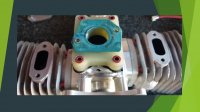 Slide5.JPG125.6 KB · Views: 857
Slide5.JPG125.6 KB · Views: 857 -
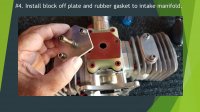 Slide6.JPG150.5 KB · Views: 863
Slide6.JPG150.5 KB · Views: 863 -
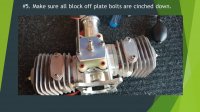 Slide7.JPG177 KB · Views: 847
Slide7.JPG177 KB · Views: 847 -
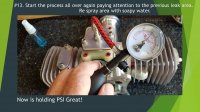 Slide15.JPG177.1 KB · Views: 852
Slide15.JPG177.1 KB · Views: 852 -
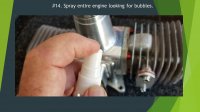 Slide16.JPG105.3 KB · Views: 819
Slide16.JPG105.3 KB · Views: 819 -
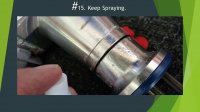 Slide17.JPG122.5 KB · Views: 822
Slide17.JPG122.5 KB · Views: 822 -
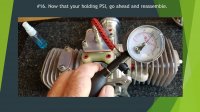 Slide18.JPG159.1 KB · Views: 854
Slide18.JPG159.1 KB · Views: 854 -
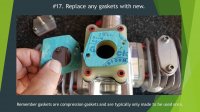 Slide19.JPG150.9 KB · Views: 843
Slide19.JPG150.9 KB · Views: 843 -
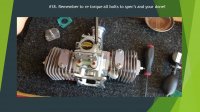 Slide20.JPG201.8 KB · Views: 897
Slide20.JPG201.8 KB · Views: 897
